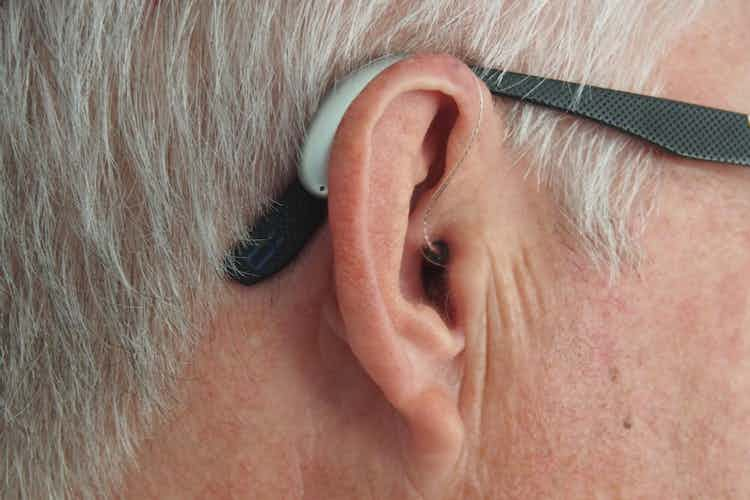Ear wax is very beneficial for our ears. Our bodies produce it naturally, acting as a natural cleanser by moving from the inside of the ear canal outward, collecting dead skin cells, hair, and dirt in the process.
But sometimes, you can have too much of a good thing. If you have blocked ears, hearing loss, earache, ringing in your ears (tinnitus), or vertigo (feeling dizzy and sick), you may have a build-up of ear wax. A survey conducted in 2022 showed that 73% of people in the UK with ear wax build-up experienced hearing loss, and 37% experienced tinnitus.
Luckily, there are plenty of options available that can help to clear out the buildup and leave you hearing great!
What is ear wax?
Ear wax, or cerumen, is a natural substance in your ears. Your ear canal glands produce it to protect your ears from harmful germs. It can be wet or dry and come in different colours. Healthy and normal ear wax can vary in colour, usually light brown, orange, or yellow. However, if ear wax appears darker in colour, it indicates that it is older and has accumulated dirt and bacteria, which causes the colour change.
What causes ear wax to build up?
There are several reasons why ear wax can build up in the ear canal, including:
- Having narrow or damaged ear canals.
- Having a skin condition that affects your scalp or your ears.
- Using cotton buds which can lead to impaction.
- Having excess ear hair.
- Regularly attending loud music venues or nightclubs.
- Dusty workplaces.
- Excess pollen in the air.
Also, as we get older, changes to the glands inside our ears cause ear wax to become drier, which makes it harder for our ears to clean themselves as effectively as they used to. This, in turn, makes it more likely that wax will build up inside the ear canal.
How can I remove ear wax?
There are several safe ways to remove ear wax.
Microsuction
Microsuction is an ear wax removal technique that uses a vacuum to remove any excess wax from your ears gently. The vacuum is attached to a very thin steel wand that a trained professional inserts into the opening of the ear. Using a microscope, they can suction out all the excess ear wax right through to the eardrum. This technique also allows them to check for any damage or perforation to the eardrum.
Sometimes, clinicians use ear drops to soften the ear wax before suctioning to make the process easier and more comfortable. Side effects of micro suction include temporary dizziness, faintness or vertigo during or shortly after the procedure.
Ear irrigation
Ear irrigation (also known as ear syringing) is a common method used to remove excess ear wax. It consists of flushing the ear canal with sterile water or saline solution. Trained professionals use a bulb syringe or small jet to pump the water, which flows behind the wax plug and back along the ear canal to gently remove the wax from the ear canal.
Side effects of ear irrigation include the possible development of otitis externa (ear canal inflammation), vertigo, and carries a small risk of causing a perforated eardrum. As a result, the NHS no longer recommends ear irrigation as a treatment for blocked ears. However, if you have had successful ear irrigation in the past and wish to continue, you can still find places offering this ear wax removal service privately.
Ear drops
If you have a feeling of fullness in your ears, a treatment as simple as ear drops can help to resolve the issue. Doctors recommend various oils for ear wax removal, including olive and almond oil.
Apply 2 to 3 drops of your preferred oil into the affected ear, repeating the process 3 to 4 times daily. For best results, continue this regimen for 3 to 5 days, as it will help to loosen excess wax and aid it to fall out naturally.
No matter which method you choose, it is important that you see an audiologist or a trained healthcare professional to carry out the procedure. This way, you can safely and hygienically remove any excess ear wax.
If the problem persists or your ear is badly blocked, and you cannot hear anything, you should make an appointment to see your GP, who can help resolve the issue or refer you to a specialist ENT (ear, nose and throat) doctor.
How often should I remove ear wax?
For most people, taking care of their ear health and removing excess wax once a year is sufficient. However, as we age, our ears require more attention, so you may need to do this process once every six months.
For people who wear hearing aids and are prone to wax build-up affecting the hearing aid's function, your practitioner might often recommend that you have a wax removal procedure every three months.
Should I remove excess ear wax?
If you suffer from ear wax build-up symptoms or have ear wax blockage, it is best to be seen by a professional and remove the excess ear wax. Research estimates that 2.3 million people in the UK suffer from excess ear wax yearly, so you are definitely not alone!
You can make an ear wax removal appointment with your local GP practice or ENT specialist. Ear wax removal is the most common ear, nose, and throat procedure performed in primary care, with approximately 4 million ears cleaned annually in the UK.
Image Credit: Mark Paton at Unsplash






